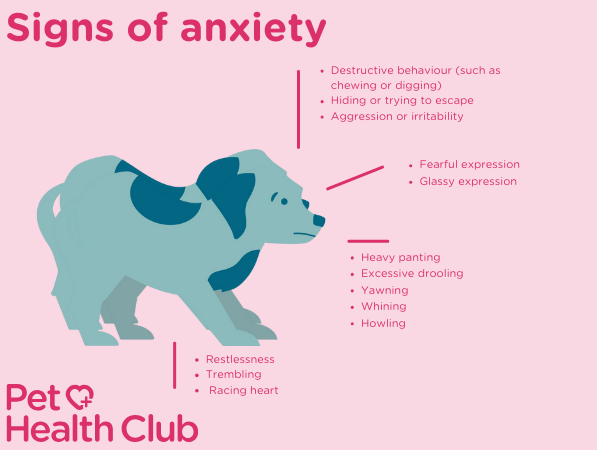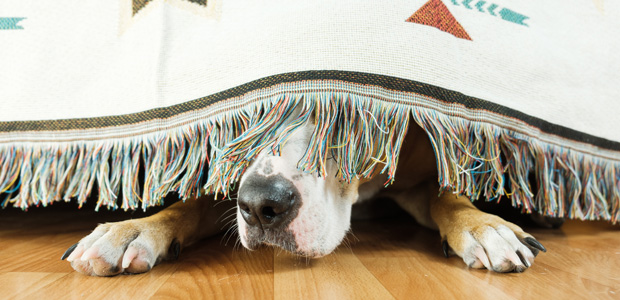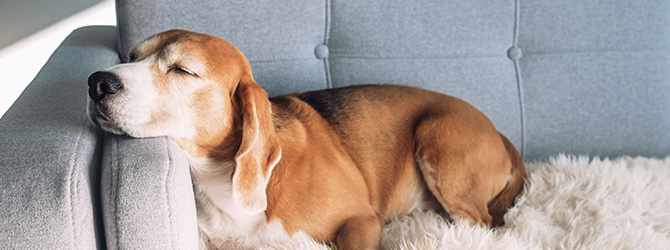How to help dogs with fireworks
Loud bangs, or bright lights, such as those made during fireworks displays, can trigger anxiety in dogs. However, there's a few ways to help your dog relax, whether they're scared of fireworks and other noises, or get anxious when you're not around.
Sound therapy uses different types of music and sounds to help your dog relax when they're feeling stressed, and can be a real lifesaver during the fireworks season.
The science behind sound therapy
Sound therapy is all about using certain sounds to help your dog's brain and body chill out. It's actually pretty cool how it works.
When your dog hears a sound, it travels in waves into their ear canal and makes the eardrum vibrate. These vibrations go to the inner ear and get turned into electrical signals that go straight to the brain.
The effects on your dog's brain are pretty much the same as they are on us humans. Certain sounds can make the brain release dopamine and serotonin, which are the feel-good chemicals in the brain. These chemicals help to lower stress and anxiety and make your dog feel calm and relaxed.
Sound therapy can actually help the part of your dog's nervous system that's in charge of relaxation work even better. This can slow down their heart rate, lower their blood pressure, and generally make them feel more at ease.

Types of sound therapy
There are several types of music that you can use for sound therapy:
Classical music
Classical music, especially music with slow tempos and gentle melodies, has been shown to have a calming effect on dogs. In a study by the Scottish SPCA and the University of Glasgow, dogs exposed to classical music showed lower stress-related behaviours. Other genres that work well are soft rock and reggae.
White noise
White noise has got all the frequencies that we can hear, and it's often used to drown out background noise and make a place feel more peaceful. It's like a big, comfy blanket for your dog's ears. It helps to mask other sounds that might make them jumpy or anxious.
Nature sounds
Nature sounds, such as birdsong, ocean waves, or rain, can calm dogs and create a natural environment that your dog is already familiar with. It's like they're back in their happy place, even if they're actually indoors. This can help them feel more at ease and less stressed.
Specially designed soundscapes
Some companies offer soundscapes specially designed for dogs. These soundscapes are designed to hit all the right notes for helping your dog relax. They blend different types of sounds that are known to make dogs feel more at ease.

How to use sound therapy for calming anxious dogs
Using sound therapy to help calm anxious dogs is a simple and effective approach. Here's how you can implement it:
Create a comfortable environment
Before introducing sound therapy, choose a quiet room or area where your dog can relax without distractions. Crate training your dog can help give them their own space and is great if they live at home with young children or other animals.
Choose the right sounds
Avoid loud, fast or erratic sounds, which could increase your dog's anxiety.
Introduce sound therapy gradually
Start by playing the sound at a low volume for 5 to 10 minutes and watch your dog's reaction. If they're relaxed and comfortable, slowly increase the volume. If you notice your dog looking a bit uncomfortable or even more anxious when you're playing these sounds, try turning down the volume a bit. If that doesn't do the trick, you might want to try a different type of sound altogether.
Use sound therapy little and often
Make sound therapy a part of your dog's daily routine. Play the calming sounds during times when you want your dog to relax, such as after a walk or when people are visiting. The more regularly you use sound therapy, the quicker your dog will get used to it. Make it a part of their daily routine, and you'll likely see them start to relax more easily over time.
Combine with other calming techniques
Consider combining sound therapy with other calming techniques, such as calming treats for dogs. Using sound therapy along with other methods can make it more effective.
Be patient
Remember, it may take time for your dog to get used to sound therapy and experience the full benefits. Be patient and continue to use sound therapy regularly, adjusting the volume and type of sounds as needed.
Desensitising your dog to loud noises
Desensitisation is a way of showing your dog that things don't have to be scary. It's all about exposing your dog to their anxiety triggers, like the loud noises from fireworks, but doing it really slowly and in a controlled way. Sound therapy can be used as part of a desensitisation training program to help your dog become less fearful of loud noises, such as fireworks or thunderstorms.
The process of desensitisation
Desensitisation and counter-conditioning is a form of dog behavioural training, aimed at reducing or changing a dog's negative response to a stimulus. It's a slow process, with the aim being to expose your dog to whatever makes them anxious (such as fireworks noise), but at such a low level it doesn't cause any stress, and then slowly crank up the intensity until your dog can tolerate their particular trigger. This is often paired with a positive reward when your dog remains calm, so that their response to the trigger, such as a thunderstorm, gradually becomes positive rather than negative.
The most important thing is to take it easy. Rushing through the process could backfire and make your dog even more anxious. So, go at a pace that's comfortable for your dog, and make sure you're not overwhelming them with too much too soon.
Coping with fireworks season
Fireworks often scare dogs, causing loads of stress and anxiety. The loud bangs, bright flashes, and unfamiliar smells can be overwhelming and without getting prepared, dogs might hide, tremble, bark or try to escape your home. Luckily, there are ways in which you can help. A desensitisation program needs to be started well in advance, but you can also use methods during the fireworks season itself to help them stay relaxed and worry free.
Advance preparation
Introduce a desensitisation program specifically for fireworks sounds. You can purchase recordings of fireworks specifically for dog desensitisation. Start by playing the sounds at a very low volume, for a short period, providing plenty of reassurance and praise. Gradually build up the volume and duration of play over the course of several weeks to months.
Make sure your dog has a safe area that they can go to when they need calm, such as a crate or cosy bed.
If you know your dog doesn't respond well to fireworks, try taking these steps to ensure their safety and comfort:
| Time | Actions |
|---|---|
| Before fireworks season |
|
| Days leading up |
|
| On bonfire night |
|
Want more advice about sound therapy for dogs?
For further help and advice on how to calm an anxious pet, particularly during firework season, have a chat with your vet.
Find your nearest vet using our find a vet page, or speak to a vet online using our video vet service.


